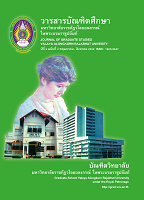ประสิทธิผลการนำนโยบายยางพาราไปปฏิบัติของสถาบันเกษตรกรยางพารา ในจังหวัดภาคใต้ตอนบน THE EFFECTIVENESS OF RUBBER POLICY IMPLEMENTATION OF AGRICULTURAL RUBBER INSTITUTIONS IN THE UPPER SOUTHERN PROVINCES
Main Article Content
Abstract
บทคัดย่อ
การวิจัยนี้มีวัตถุประสงค์ 1) เพื่อศึกษาประสิทธิผลการนำนโยบายยางพาราไปปฏิบัติของสถาบันเกษตรกรยางพาราในจังหวัดภาคใต้ตอนบน 2) เพื่อศึกษาปัจจัยที่มีอิทธิพลต่อประสิทธิผลการนำนโยบายยางพาราไปปฏิบัติของสถาบันเกษตรกรยางพาราในจังหวัดภาคใต้ตอนบน และ 3) เพื่อศึกษาแนวทางในการปรับปรุงประสิทธิผลการนำนโยบายยางพาราไปปฏิบัติของสถาบันเกษตรกรยางพาราในจังหวัดภาคใต้ตอนบน โดยใช้การวิจัยแบบผสานวิธี ประกอบด้วยการวิจัยเชิงคุณภาพและการวิจัยเชิงปริมาณ การวิจัยเชิงคุณภาพดำเนินการโดยการสัมภาษณ์เชิงลึกผู้ให้ข้อมูลสำคัญ จำนวน 25 คน ประกอบด้วย ผู้เชี่ยวชาญด้านการพัฒนายางพารา จำนวน 15 คน และผู้มีส่วนเกี่ยวข้องในการพัฒนายางพารา 10 คน ที่ได้มาด้วย การเลือกแบบเจาะจง วิเคราะห์ข้อมูลโดยการอุปมานวิเคราะห์และการตีความการวิจัยเชิงปริมาณดำเนินการโดยการศึกษากลุ่มตัวอย่าง จำนวน 219 คน ที่เลือกมาจากประชากร จำนวน 486 คน ที่เป็นข้าราชการ/พนักงาน/ลูกจ้าง และพนักงานจ้างที่ปฏิบัติงานในสถาบันเกษตรกรยางพาราในจังหวัดภาคใต้ตอนบน ด้วยการสุ่มตัวอย่างแบบแบ่งชั้นภูมิตามสัดส่วน และการสุ่มตัวอย่างแบบง่ายกำหนดขนาดกลุ่มตัวอย่างโดยการคำนวณตามสูตรของทาโร่ ยามาเน่ เครื่องมือที่ใช้ในการเก็บข้อมูล คือ แบบสอบถามแบบมาตราส่วนประมาณค่า 5 ระดับ ที่มีความเชื่อมั่น 0.87 และวิเคราะห์ข้อมูลด้วยสถิติค่าร้อยละ ค่าเฉลี่ย ค่าส่วนเบี่ยงเบนมาตรฐาน และการวิเคราะห์การถดถอยแบบขั้นตอน
ผลการวิจัยพบว่า
1) ประสิทธิผลการนำนโยบายยางพาราไปปฏิบัติของสถาบันเกษตรกรยางพาราในจังหวัดภาคใต้ตอนบนโดยรวมอยู่ในระดับปานกลาง ( =3.34) เมื่อพิจารณาเป็นรายด้าน พบว่า ด้านบรรลุวัตถุประสงค์อยู่ในระดับสูงสุด (
=3.36) รองลงมา คือ ด้านความยั่งยืนของอุตสาหกรรมยาง (
=3.36) ด้านความพึงพอใจของผู้เกี่ยวข้อง (
=3.35) และด้านการมีประโยชน์อย่างแท้จริงต่อส่วนรวม (
=3.28) ตามลำดับโดยด้านการบรรลุวัตถุประสงค์ที่อยู่ในระดับสูงที่สุดนั้น เนื่องจากวัตถุประสงค์ของนโยบายที่กำหนดไว้สอดคล้องกับความต้อง การของเกษตรกรในการเพิ่มรายได้ และด้านการมีประโยชน์อย่างแท้จริงต่อส่วนรวมที่อยู่ในระดับต่ำสุดนั้น เนื่องจากนโยบายยางพาราที่กำหนดไว้นี้ มุ่งเน้นประโยชน์แก่เกษตรกรเป็นหลัก จึงทำให้เกิดประโยชน์ต่อส่วนรวมน้อยลง
2) ปัจจัยที่มีอิทธิพลต่อประสิทธิผลการนำนโยบายยางพาราไปปฏิบัติของสถาบันเกษตรกรยางพาราในจังหวัดภาคใต้ตอนบนพิจารณาตามสมการพยากรณ์ พบว่า ตัวแปรอิสระที่ได้รับการคัดเลือกเข้าสมการตามลำดับความสัมพันธ์อย่างมีนัยสำคัญทางสถิติที่ระดับ 0.05 ประกอบด้วย 4 ตัวแปร คือ (1) ด้านการสนับสนุนจากภาครัฐ (2) ด้านภาวะผู้นำ (3) ด้านความพร้อมด้านทรัพยากรการบริหารและ (4) ด้านความร่วมมือของเกษตรกรโดยทั้ง 4 ปัจจัย ดังกล่าวสามารถอธิบายความผันแปรของประสิทธิผลการนำนโยบายยางพาราไปปฏิบัติของสถาบันเกษตรกรยางพาราได้ร้อยละ 96.10 (Adjusted R² = 0.961)
3) แนวทางการปรับปรุงประสิทธิผลการนำนโยบายยางพาราไปปฏิบัติของสถาบันเกษตรกรยางพาราในจังหวัดภาคใต้ตอนบนที่เสนอแนะประกอบด้วยการปฏิบัติที่สำคัญ 6 ประการคือ (1) ควรพัฒนาวัตถุประสงค์ของนโยบายยางพาราให้มีความกว้างขวางมากขึ้น โดยเพิ่มเติมการจัดทำแผนการบริหารจัดการผลผลิตยางพาราให้ได้คุณภาพและมีผลผลิตต่อพื้นที่สูงขึ้น (2) ควรเพิ่มนโยบายยางพาราให้มีประโยชน์ต่อส่วนรวมมากขึ้น โดยมีการกำหนดนโยบายให้มีการใช้ยางธรรมชาติในประเทศเพิ่มมากขึ้น (3) ควรเพิ่มการสนับสนุนจากภาครัฐโดยสนับสนุนให้ภาคเอกชนรายใหญ่ได้ปรับปรุงเครื่องจักรรองรับการผลิตสินค้าจากยางพารา (4) ควรเพิ่มภาวะผู้นำโดยให้ผู้นำเป็นผู้รู้เท่าทันสถานการณ์และสามารถปรับตัวให้เข้ากับการเปลี่ยนแปลงได้อย่างเหมาะสม (5) ควรเพิ่มความพร้อมด้านทรัพยากรการบริหารโดยจัดให้มีการบริหารค่าตอบแทนผลประโยชน์และสวัสดิการแก่บุคลากรอย่างเหมาะสม และ (6) ควรเพิ่มความร่วมมือของเกษตรกรโดยพัฒนาความร่วมมือในการลงทุนและ การปฏิบัติงานโดยเฉพาะอย่างยิ่งในด้านแรงงาน
ABSTRACT
The objectives of this research were 1) to study the effectiveness of the rubber policy implementation of agricultural rubber institutions in the Upper Southern provinces, 2) to study the factors influencing the effectiveness of the rubber policy implementation of agricultural rubber institutions in the Upper Southern provinces, and 3) to propose the recommendations for improving the effectiveness of the rubber policy implementation of agricultural rubber institutions in the Upper Southern provinces. This research was a mixed methods using bolt quantitative and qualitative approaches. The qualitative research was conducted by in-depth interviewing 25 key informants consisted of the experts in rubber development and they were selected by purposive sampling technique. The Data were analyzed by using analytic induction and interpretation. The quantitative research was conducted by using the sample of 219 respondents who were selected form the officials, staffs and employees working in the Upper Southern provinces, they were selected by proportional stratified random sampling technique. The sample size was obtained by the calculation using Taro Yamane formula. The research tool for data collection was five levels rating scale at the reliability 0.87. The statistics used for data analysis composed of means, standard deviation and the hypothesis were tested by stepwise regression analysis.
The research findings were as follows:
1) The effectiveness of rubber policy implementation of agricultural rubber institutions in the Upper Southern provinces in overall was at the moderate level ( =3.34). While considered in each aspect, it was found that the aspect of objective attainment was at the highest level (
=3.36), followed by the aspect of rubber industry sustainability (
=3.36), the aspect of stakeholder satisfaction ( =3.35), and the aspect of actual public benefit (
=3.28), respectively. The aspect of objective attainment was at the highest level as the objective of this policy was complied with the needs of the rubber agriculturalists to increase their incomes. The aspect of actual public benefit was at the lowest as this policy focused mainly on the benefit of the rubber agriculturalists that brought about less actual public benefit.
2) The factors influencing the effectiveness of the rubber policy implementation of agricultural rubber institutions in the Upper Southern provinces based on the prediction equation and ranking from the highest consisted of 4 aspects: (1) the aspect of the governmental support, (2) the aspect of leadership, (3) the readiness of managerial resource aspect and (4) the cooperation of agriculturalists aspect. These four variables could explain the variation of the effectiveness of the rubber policy implementation of agricultural rubber institutions at 96.10 percent (Adjusted R²=0.9610) at the level of significance of 0.05
3) The proposed recommendations for improving the effectiveness of rubber policy implementation of agriculture rubber institutions consisted of 6 principle measures as follows: (1) the objectives of rubber policy should be expanded by having more production plans in getting higher qualities and more products per production areas, (2) the rubber policy should be increased to prides more public benefits by increasing internal consumption, (3) the governmental support should be facilitated by encouraging the private sectors in improving their own producing machines, (4) the leadership should be enhanced by acknowledging the leaders in having broader vision and being appropriate leader for change, (5) the managerial resources should be increased by setting up the appropriate benefit system and having suitable welfare for all personnel and (6) the cooperation of all agriculturalists should be enhanced by developing the joint venture in investment and performing, especially in the labor sectors.Article Details
บทความทุกเรื่องได้รับการตรวจความถูกต้องทางวิชาการโดยผู้ทรงคุณวุฒิ ทรรศนะและข้อคิดเห็นในบทความวารสารบัณฑิตศึกษา มหาวิทยาลัยราชภัฏวไลยอลงกรณ์ ในพระบรมราชูปถัมภ์ มิใช่เป็นทรรศนะและความคิดของผู้จัดทำจึงมิใช่ความรับผิดชอบของบัณฑิตวิทยาลัย มหาวิทยาลัยราชภัฏวไลยอลงกรณ์ ในพระบรมราชูปถัมภ์ กองบรรณาธิการไม่สงวนสิทธิ์การคัดลอก แต่ให้อ้างอิงแหล่งที่มา


